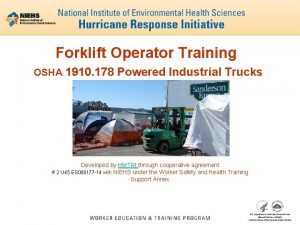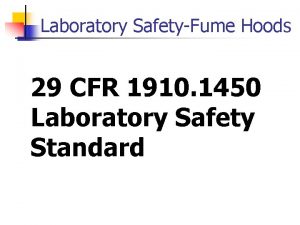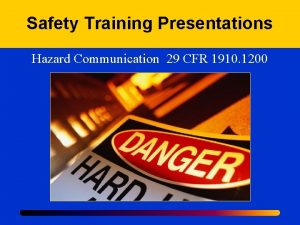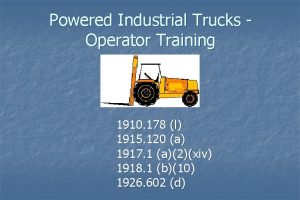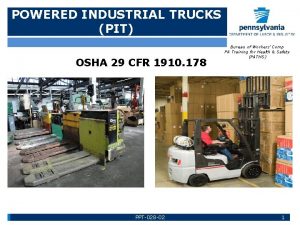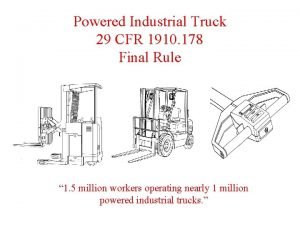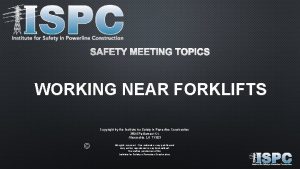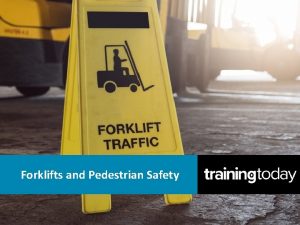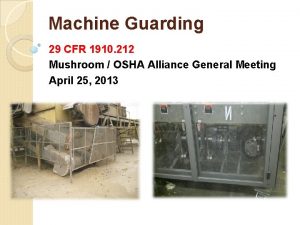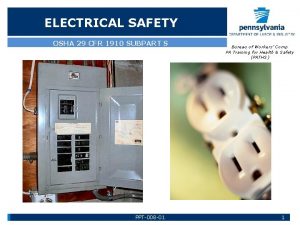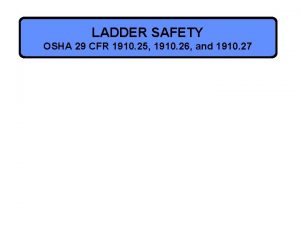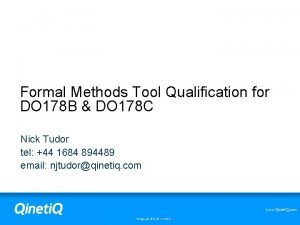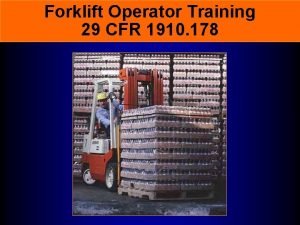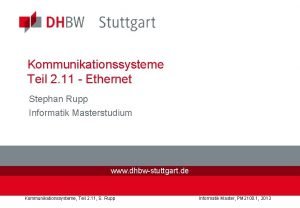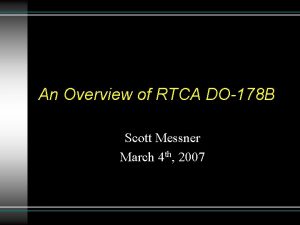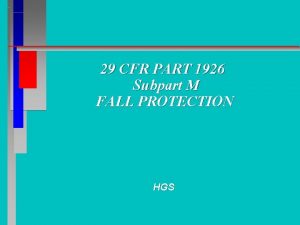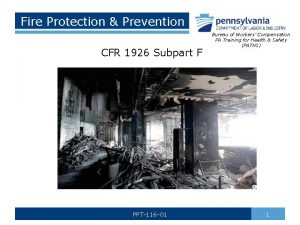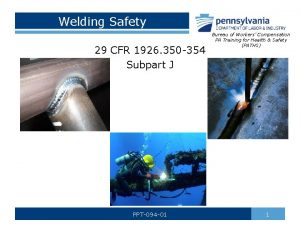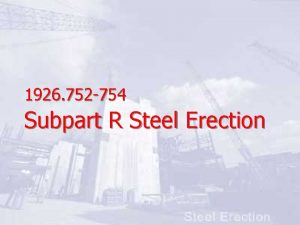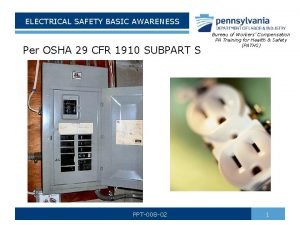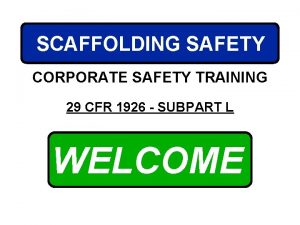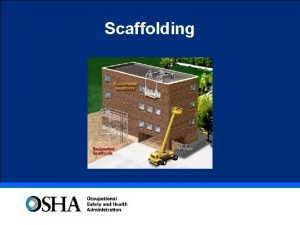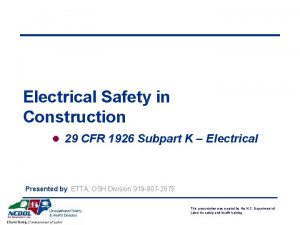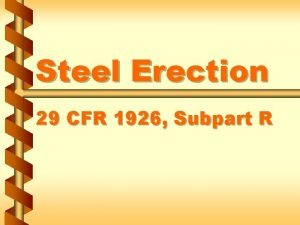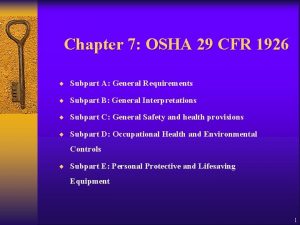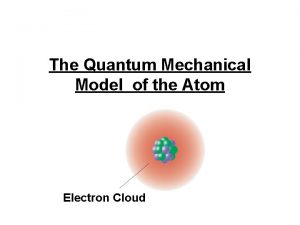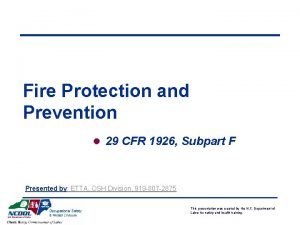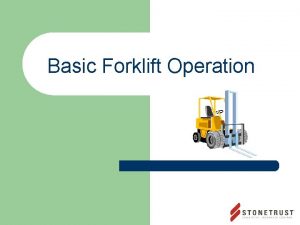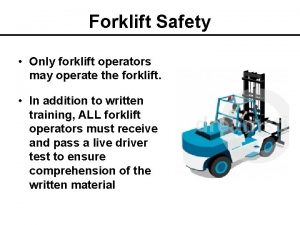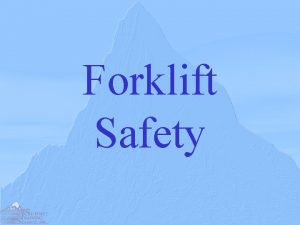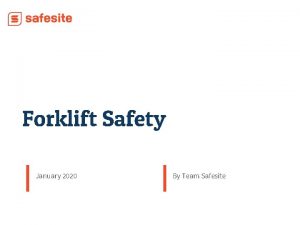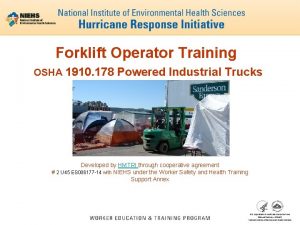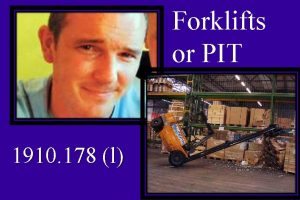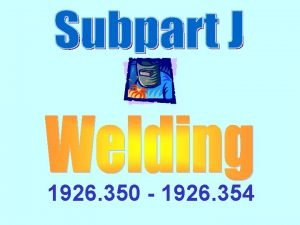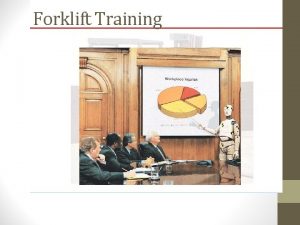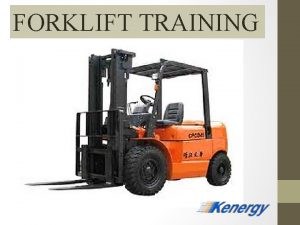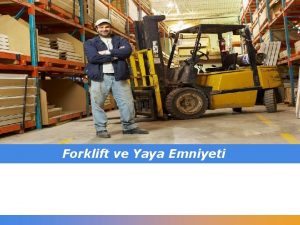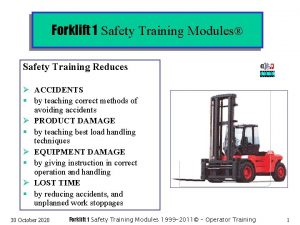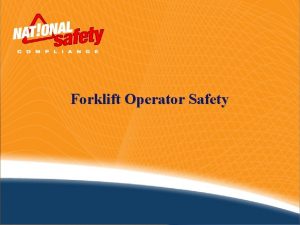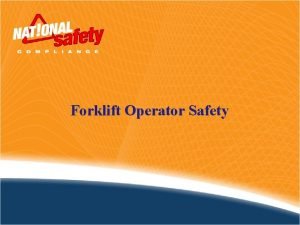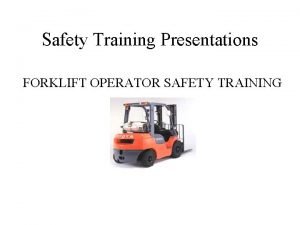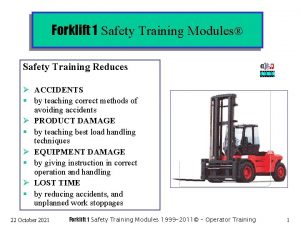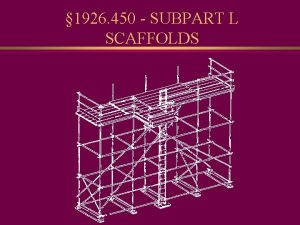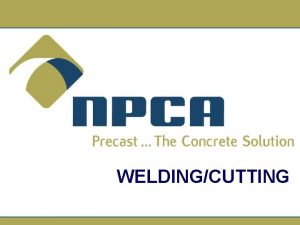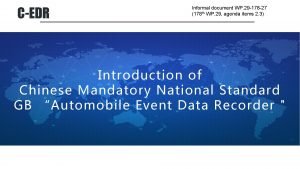Forklift Safety 1926 602d 1910 178 1910 178




































- Slides: 36

Forklift Safety 1926. 602(d) 1910. 178

1910. 178 (a) Powered industrial trucks • General Requirements • (1) Contains safety requirements relating to: – Fire protection, – Design, – Maintenance, and – Use of fork trucks, tractors, platform lift trucks, motorized hand trucks, and other specialized industrial trucks powered by electric motors or internal combustion engines

1910. 178 (a) Powered industrial trucks • (2) Meet the design and construction requirements for powered industrial trucks established in the "American National Standard for Powered Industrial Trucks, Part II, ANSI B 56. 1 -1969” • (3) Approved trucks shall bear a label or some other identifying mark indicating approval by a nationally recognized testing laboratory

1910. 178 (a) Powered industrial trucks • (4) Modifications and additions which affect capacity and safe operation shall not be performed by the customer or user without manufacturers prior written approval

1910. 178 (a) Powered industrial trucks • (6) All nameplates and markings are in place and are maintained in a legible condition

1910. 178 (e) Powered industrial trucks • Safety Guards • (1) High Lift Rider trucks shall be fitted with an overhead guard…unless operations do not permit • (2) If the type of load presents a hazard, the user shall equip fork trucks with a vertical load backrest extension

1910. 178(f) Fuel Handling and Storage • (1)The storage and handling of liquid fuels such as gasoline and diesel fuel shall be in accordance with NFPA Flammable and Combustible Liquids Code (NFPA No. 30 -1969) • (2)The storage and handling of liquefied petroleum gas fuel shall be in accordance with NFPA Storage and Handling of Liquefied Petroleum Gases (NFPA No. 58 -1969)

1910. 178(g) Changing and charging storage batteries • (1)Battery charging installations shall be located in areas designated for that purpose • (2)Facilities provided for – Flushing and neutralizing spilled electrolyte, – For fire protection, – For protecting charging apparatus from damage by trucks, and – For adequate ventilation for dispersal of fumes from gassing batteries

Standard Interpretations 03/08/2002 - Clarification of PIT requirements covering: LP-gas storage, and eye wash stations. • Must LP cylinders used for internal combustion forklifts be stored outside only, or is it permissible to store them inside a warehouse or industrial building? : § 1910. 178(f)(2) addresses the storage and handling of liquified petroleum by incorporating by reference the National Fire Protection Association standard, NFPA 58 -1969, Storage and Handling of Liquified Petroleum Gases. • This document lists the requirements for storage of LP cylinders in areas such as within buildings frequented by the public, buildings not frequented by the public, special buildings or rooms, and outside of buildings.

Standard Interpretations 03/08/2002 - Clarification of PIT requirements covering: LP-gas storage, and eye wash stations. • What regulations state how close eyewash station must be to a battery changing/charging station? • Because § 1910. 178 does not have a specific requirement for eyewash facilities, the general standard at § 1910. 151 applies. When necessary, facilities for drenching or flushing the eyes “shall be provided within the work area for immediate emergency use. ”

Standard Interpretations 03/08/2002 - Clarification of PIT requirements covering: LP-gas storage, and eye wash stations. • In applying these general terms, OSHA would consider the guidelines set by such sources as American National Standards Institute (ANSI) Z 358. 1 -1998, Emergency Eyewash and Shower Equipment, which states, at section 7. 4. 4, that eyewash facilities are to be located to require no more than 10 seconds to reach but that where a strong acid or caustic is used, the unit should be immediately adjacent to the hazard.

1910. 178(g) Changing and charging storage batteries • (4)A conveyor, overhead hoist, or equivalent material handling equipment shall be provided for handling batteries

1910. 178(g) Changing and charging storage batteries • (5)Reinstalled batteries shall be properly positioned and secured in the truck

1910. 178(g) Changing and charging storage batteries • (7)When charging batteries, acid poured into water; not water poured into acid • (8)Trucks properly positioned and brake applied before attempting to change or charge batteries • (9)Care taken to assure that vent caps are functioning

1910. 178(g) Changing and charging storage batteries • (10)Smoking shall be prohibited in the charging area • (11)Precautions shall be taken to prevent open flames, sparks, or electric arcs in battery charging areas DANGER • (12) Tools and metallic objects shall be kept away from the tops of batteries DANGER No smoking sparks or open flames

Standard Interpretations 03/08/2002 - Clarification of PIT requirements covering: smoking. • Are there any regulations that prohibit smoking on powered industrial trucks of any classification or fuel designation? • § 1910. 178 does not address smoking except to prohibit smoking in the battery charging areas (§ 1910. 178(g)(10)). • There are other OSHA standards which may apply, however, such as these dealing with the presence of flammable liquids or atmospheres or other regulated substances.

1910. 178(h) Lighting for operating areas • Where general lighting is less than 2 lumens per square foot, auxiliary directional lighting shall be provided on the truck

1910. 178(k) Trucks and railroad cars • The brakes of highway trucks set and wheel chocks placed under the rear wheels to prevent the trucks from rolling while they are boarded with powered industrial trucks • Wheel stops or other recognized positive protection shall be provided to prevent railroad cars from moving during loading or unloading operations

1910. 178(l) Operator training • (1)Ensure that each powered industrial truck operator is competent to operate a powered industrial truck safely • Prior to permitting an employee to operate a powered industrial truck (except for training purposes), the employer shall ensure that each operator has successfully completed the training required Required: • Lecture • Practical training • Evaluation

1910. 178(l) Operator training • (2)(i)Trainees may operate a powered industrial truck only: • (A)Under the direct supervision of persons who have the knowledge, training, and experience to train operators and evaluate their competence; and • (B)Where such operation does not endanger the trainee or other employees.

1910. 178(l) Operator training • (2)(ii)Training shall consist of a combination of: – Formal instruction (e. g. , lecture, discussion, interactive computer learning, video tape, written material), – Practical training (demonstrations performed by the trainer and practical exercises performed by the trainee), and – Evaluation of the operator's performance in the workplace.

1910. 178(l) Operator training • (2)(iii) All operator training and evaluation shall be conducted by persons who have the knowledge, training, and experience to train powered industrial truck operators and evaluate their competence.

1910. 178(l) Operator training • (3)Training topics: – Operating instructions, warnings, and precautions; – Differences between the truck and the automobile; – Truck controls and instrumentation: • where they are located, • what they do, and • how they work; – Engine or motor operation; – Steering and maneuvering; – Fork and attachment adaptation;

1910. 178(l) Operator training • Training topics (contd. ): – Vehicle capacity; – Vehicle stability; – Any vehicle inspection and maintenance that the operator will be required to perform; – Refueling and/or charging and recharging of batteries; – Operating limitations; – operating instructions, warnings, or precautions listed in the operator's manual

1910. 178(l)(3)(ii) Workplace-related topics: – Surface conditions where the vehicle will be operated; – Composition of loads to be carried and load stability; – Load manipulation, stacking, and unstacking; – Pedestrian traffic in areas where the vehicle will be – Ramps and other sloped surfaces that could affect the vehicle's stability; operated;

1910. 178(l) Certification • (6)The certification shall include: – The name of the operator; – The date of the training; – The date of the evaluation, and; – The identity of the person(s) performing the training or evaluation PIT Training & Evaluation

1910. 178(m) Truck operations • (1)Trucks never driven up to anyone standing in front of a bench or other fixed object • (2)No one allowed to stand or pass under the elevated portion of any truck, whether loaded or empty • (3)Unauthorized personnel not permitted to ride on powered industrial trucks • A safe place to ride provided where riding of trucks is authorized

1910. 178(m) Truck operations • (4)Prohibit arms or legs from being placed between the uprights of the mast or outside the running lines of the truck • (5)(i)Truck left unattended, load engaging means fully lowered, controls neutralized, power shall be shut off, and brakes set* *A powered industrial truck is unattended when the operator is 25 ft. or more away from the vehicle which remains in his view, or whenever the operator leaves the vehicle and it is not in his view

1910. 178(m) Truck operations • (6)A safe distance shall be maintained from the edge of ramps or platforms while on any elevated dock, or platform or freight car. • Trucks shall not be used for opening or closing freight doors. • (7)Brakes shall be set and wheel blocks shall be in place to prevent movement of trucks, trailers, or railroad cars while loading or unloading. • (7)The flooring of trucks, trailers, and railroad cars shall be checked for breaks and weakness before they are driven onto.

1910. 178(m) Truck operations • (9)An overhead guard shall be used as protection against falling objects. • It should be noted that an overhead guard is intended to offer protection from the impact of small packages, boxes, bagged material, etc. , representative of the job application, but not to withstand the impact of a falling capacity load.

1910. 178(m) Truck operations • (12)(i)Use of a safety platform firmly secured to the lifting carriage and/or forks • (ii)Means shall be provided whereby personnel on the platform can shut off power to the truck

Safety platform detail

Safety platform detail

Standard Interpretations 03/08/2002 - Clarification of PIT requirements covering: fall protection and safety platforms • Are safety platforms attached to the forks of a forklift considered aerial lifts? No, Aerial devices (aerial lifts) are covered under § 1910. 67, Vehicle-mounted Elevating and Rotating Work Platforms. An aerial device is any vehicle-mounted device that telescopes, articulates or both, which is used to position personnel. A platform attached to the forks of a forklift would not be considered an aerial lift.

Standard Interpretations 03/08/2002 - Clarification of PIT requirements covering: fall protection and safety platforms • Are workers required to wear fall protection (full body harness and lanyard) when they are up in a safety platform that has a standard guardrail, mid-rail and toe plate? No, personal fall protection equipment would not be required when a guardrail system is installed along the open sides of the safety platform.

1910. 178(n) Traveling • (1)All traffic regulations shall be observed, including authorized plant speed limits; Speed Limit 5 mph • A safe distance shall be maintained approximately three truck lengths from the truck ahead, and; Three truck lengths minimum • The truck shall be kept under control at all times
 29 cfr 1910 osha 178
29 cfr 1910 osha 178 29 cfr 1910 osha 178
29 cfr 1910 osha 178 29 cfr 1910
29 cfr 1910 29 cfr 1910 osha 178
29 cfr 1910 osha 178 29 cfr 1910 powered industrial trucks
29 cfr 1910 powered industrial trucks 29cfr1910.178
29cfr1910.178 29 cfr 1910 powered industrial trucks
29 cfr 1910 powered industrial trucks Forklift safety meeting topics
Forklift safety meeting topics Forklift pedestrian safety
Forklift pedestrian safety Osha conveyor safety 1910
Osha conveyor safety 1910 Cfr 1910 subpart s
Cfr 1910 subpart s Ladder storage osha
Ladder storage osha Pressione osmotica
Pressione osmotica Histor
Histor 29cfr1910.178
29cfr1910.178 192-168-178-21
192-168-178-21 Rtca do-178
Rtca do-178 192-168-178-22
192-168-178-22 Vc
Vc 178 questions qcm aipr
178 questions qcm aipr 29 cfr 1926 subpart m
29 cfr 1926 subpart m Osha 1926 fire extinguisher
Osha 1926 fire extinguisher Osha 1926 welding
Osha 1926 welding 1926 silica
1926 silica Nowela sierpniowa
Nowela sierpniowa During steel floor assembly shear connectors
During steel floor assembly shear connectors Tratado alfaro kellogs
Tratado alfaro kellogs Osha 1926 extension cords
Osha 1926 extension cords 1926 scaffolding
1926 scaffolding 1926 scaffolding
1926 scaffolding Osha 1926 extension cords
Osha 1926 extension cords Subpart r training
Subpart r training Katal architekt antoni
Katal architekt antoni Osha 1926 subpart c
Osha 1926 subpart c Quantum mechanical model 1926
Quantum mechanical model 1926 Osha 1926 fire extinguisher
Osha 1926 fire extinguisher Onde nasceu o pintor e escultor lasar segall
Onde nasceu o pintor e escultor lasar segall
